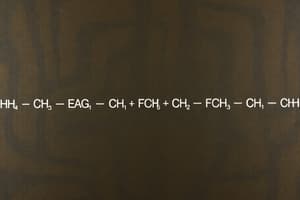Podcast
Questions and Answers
What is the expression that shows the elements in a compound and their relative proportions?
What is the expression that shows the elements in a compound and their relative proportions?
Chemical formula
What elements make up water (H2O) and in what ratio?
What elements make up water (H2O) and in what ratio?
Hydrogen and oxygen in a 2:1 ratio
What does the charge of an atom represent in relation to valence electrons?
What does the charge of an atom represent in relation to valence electrons?
The number of valence electrons lost or gained
What is the charge of an atom that loses electrons?
What is the charge of an atom that loses electrons?
What is the order for writing and naming ionic compounds?
What is the order for writing and naming ionic compounds?
What is the formula for sodium chloride?
What is the formula for sodium chloride?
What suffix is used to name the anion derived from a metal in ionic compounds?
What suffix is used to name the anion derived from a metal in ionic compounds?
If the name of the oxyanion ends in -ate, the name of the oxyacid will be _______ -ic acid.
If the name of the oxyanion ends in -ate, the name of the oxyacid will be _______ -ic acid.
What does the old naming system for variable oxidation states involve?
What does the old naming system for variable oxidation states involve?
Match the following ionic compounds with their names:
Match the following ionic compounds with their names:
What are hydrates?
What are hydrates?
What is the name of the compound with the formula (NH4)3PO4?
What is the name of the compound with the formula (NH4)3PO4?
Flashcards are hidden until you start studying
Study Notes
Chemical Formulas and Compounds
- Chemical Formula: An expression that shows the elements in a compound and the relative proportions of those elements. For example, H2O (Water) is composed of hydrogen and oxygen in a 2:1 ratio.
Oxidation Numbers
- Oxidation Number: A positive or negative integer related to the electronic structure of an atom. It keeps track of the number of valence electrons lost or gained.
- The oxidation number is the same as the charge of an ion.
- An atom that loses electrons has a positive charge (+).
- An atom that gains electrons has a negative charge (-).
- Note: For a polyatomic ion, the charge of the ion differs from the oxidation number of the elements that make up the polyatomic ion.
Naming Ionic Compounds
- Writing Ionic Compounds:
- Write the metal (cation) first, followed by the non-metal (anion).
- Use the cross-over rule: Use the absolute value of the charges (oxidation numbers) of the anion as the subscript for the cation, and the absolute value of the cation charge as the subscript for the anion. For example, Na1Cl1 simplifies to NaCl.
- Examples: Mg3(PO4)2, Ca2(SO4)2 simplifies to CaSO4
- Naming Ionic Compounds:
- The name of the metal (+ion) is given first, followed by the non-metal (-ion).
- The cation carries the name of the metal, while the name of the anion is derived by changing the ending to "-ide."
- Examples: LiBr (Lithium bromide), Na2O (Sodium oxide), AlI3 (Aluminum iodide)
Naming Ionic Compounds with Variable Oxidation Numbers
- Variable Oxidation States: Metals with variable oxidation states can be named in two ways:
- Old System: The Latin name of the cation with the lower oxidation state is modified to end in "-ous," while the cation with the higher oxidation state will end in "-ic."
- Stock System: The English name of the metal is used, and the oxidation state is indicated by a Roman numeral enclosed in parentheses. For example, FeCl2 is Iron (II) chloride, and Fe2(SO4)3 is Iron (III) sulfate.
Naming Hydrates
- Hydrates: Ionic compounds that absorb water into their solid structures.
- Anhydrous Substances: Water-free substances.
- Anhydrous Copper (II) Sulfate is nearly white. It absorbs water and turns blue. Copper (II) Sulfate that is fully hydrated contains 5 molecules of water.
- A dot (.) is used to separate the water molecule in the formula.
- For example, Copper (II) Sulfate pentahydrate is written as CuSO4.5H2O.
Naming Ionic Compounds with Polyatomic Ions
- Polyatomic Ions: Name the first polyatomic ion followed by the second polyatomic ion.
- For example, (NH4)3PO4 is Ammonium phosphate.
Compounds of Non-metals
- Non-metal with Non-metal:
- The name of the element whose symbol appears first in the formula is written first.
- The second part of the name is formed by adding the suffix "-ide" to the stem of the second non-metal.
- Examples: HCl (Hydrogen Chloride), H2S (Hydrogen Sulfide)
Naming Compounds with Multiple Non-metals
- Multiple Non-metals: If more than one compound is formed by a pair of non-metals, Greek prefixes are used to indicate the number of atoms of each element present.
- Examples:
- NO (Nitrogen oxide), CO (Carbon monoxide)
- NO2 (Nitrogen dioxide), CO2 (Carbon dioxide)
- N2O (Dinitrogen oxide), CO3 (Carbon trioxide)
- N2O4 (Dinitrogen tetroxide), SO2 (Sulfur dioxide)
- SO3 (Sulfur trioxide)
- Examples:
Oxyanions
- Oxyanions: These are derived from oxyanions.
- Examples:
- ClO4- (perchlorate), BrO4- (perbromate)
- ClO3- (chlorate), BrO3- (bromate)
- ClO2- (chlorite), BrO2- (bromite)
- ClO- (hypochlorite), BrO- (hypobromite)
- Examples:
Naming Oxyacids
- Oxyacids: The name of the oxyacid is derived from the name of the oxyanion with some modification in the suffix.
-
If the name of the oxyanion ends in "-ate," the name of the oxyacid will be "-ic acid."
-
For example:
- SO42- (sulfate) becomes H2SO4 (sulfuric acid)
- ClO4- (perchlorate) becomes HClO4 (perchloric acid)
- BrO3- (bromate) becomes HBrO3 (bromic acid)
-
If the name of the oxyanion ends in "-ite," the name of the oxyacid will be "-ous acid."
-
For example:
- SO32- (sulfite) becomes H2SO3 (sulfurous acid)
- ClO- (hypochlorite) becomes HClO (hypochlorous acid)
- BrO- (hypobromite) becomes HBrO (hypobromous acid)
-
Studying That Suits You
Use AI to generate personalized quizzes and flashcards to suit your learning preferences.




